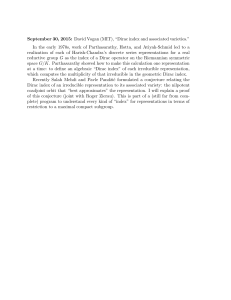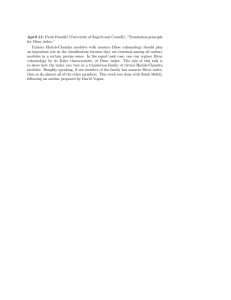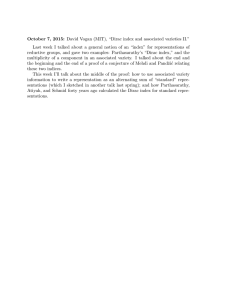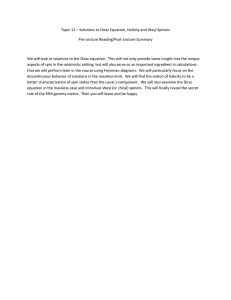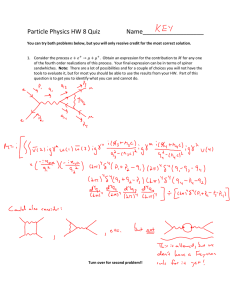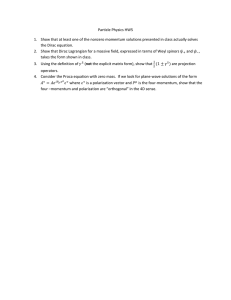10 Lecture 10 (Notes: K. ...
advertisement
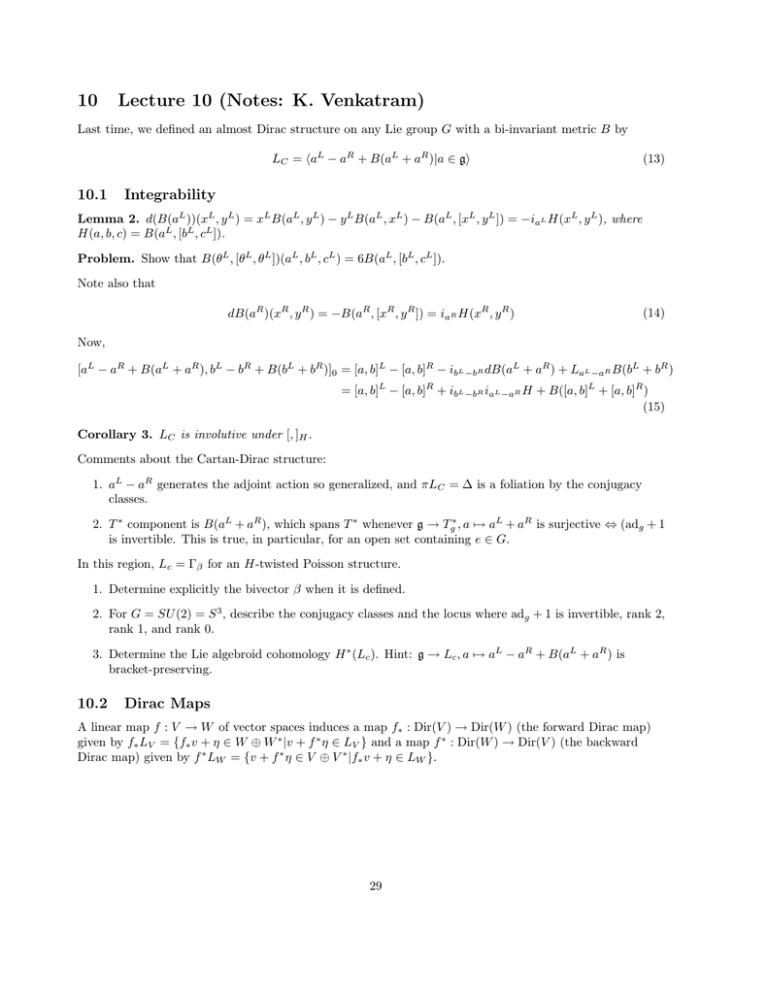
10
Lecture 10 (Notes: K. Venkatram)
Last time, we defined an almost Dirac structure on any Lie group G with a bi-invariant metric B by
LC = �aL − aR + B(aL + aR )|a ∈ g�
10.1
(13)
Integrability
Lemma 2. d(B(aL ))(xL , y L ) = xL B(aL , y L ) − y L B(aL , xL ) − B(aL , [xL , y L ]) = −iaL H(xL , y L ), where
H(a, b, c) = B(aL , [bL , cL ]).
Problem. Show that B(θL , [θL , θL ])(aL , bL , cL ) = 6B(aL , [bL , cL ]).
Note also that
dB(aR )(xR , y R ) = −B(aR , [xR , y R ]) = iaR H(xR , y R )
(14)
Now,
[aL − aR + B(aL + aR ), bL − bR + B(bL + bR )]0 = [a, b]L − [a, b]R − ibL −bR dB(aL + aR ) + LaL −aR B(bL + bR )
= [a, b]L − [a, b]R + ibL −bR iaL −aR H + B([a, b]L + [a, b]R )
(15)
Corollary 3. LC is involutive under [, ]H .
Comments about the Cartan-Dirac structure:
1. aL − aR generates the adjoint action so generalized, and πLC = Δ is a foliation by the conjugacy
classes.
2. T ∗ component is B(aL + aR ), which spans T ∗ whenever g → Tg∗ , a �→ aL + aR is surjective ⇔ (adg + 1
is invertible. This is true, in particular, for an open set containing e ∈ G.
In this region, Lc = Γβ for an H-twisted Poisson structure.
1. Determine explicitly the bivector β when it is defined.
2. For G = SU (2) = S 3 , describe the conjugacy classes and the locus where adg + 1 is invertible, rank 2,
rank 1, and rank 0.
3. Determine the Lie algebroid cohomology H ∗ (Lc ). Hint: g → Lc , a �→ aL − aR + B(aL + aR ) is
bracket-preserving.
10.2
Dirac Maps
A linear map f : V →W of vector spaces induces a map f∗ : Dir(V ) → Dir(W ) (the forward Dirac map)
given by f∗ LV = {f∗ v + η ∈ W ⊕ W ∗ |v + f ∗ η ∈ LV } and a map f ∗ : Dir(W ) → Dir(V ) (the backward
Dirac map) given by f ∗ LW = {v + f ∗ η ∈ V ⊕ V ∗ |f∗ v + η ∈ LW }.
29
Example.
�2
β∈
V . Then
f∗ Γβ = {f∗ v + η|v + f ∗ η = β(ξ) + ξ∀ξ ∈ V ∗ } = {f∗ βf ∗ η + η|η ∈ W ∗ }
= {(f∗ β)(η) + η} = Γf∗ β
(16)
so f∗ coincides with the usual pushforward.
�2 ∗
L = L(E, �), f : E �→ V, � ∈
E . Then L is precisely f∗ Γ� via the pushforward E ⊕ E ∗ → V ⊕ V ∗ .
�2 ∗
In general, L = L(F, γ), F ⊂ V ∗ , γ ∈
F is equivalent to specifying
�2 ∗ � 2
�2
F =
(V /L ∩ V ) =
(V /C)). Note that (f∗ LV ) ∩ W = f∗ (LV ∩ V ).
(C = Ann F = L ∩ V, γι
Problem. f∗ L(C, γ) = L(f∗ C, f∗ γ).
This proves that pushforward commutes properly with composition.
10.3
Manifolds with Courant Structure
Let (M, HM ), (N, HN ) be manifolds equipped with H ∈ Ω3 )cl-structure.
Definition 17. A morphism Φ : (M, HM ) →(N, HN ) is a pair (φ, B) for φ : M → N a smooth map and
B ∈ Ω2 (M ) s.t. φ∗ HN − HM = dB, i.e. B gives an isomorphism φ∗ GN → GM .
Now, suppose that LM ⊂ T M ⊕ T ∗ M, LN ⊂ T N ⊕ T ∗ N are Dirac structures.
Definition 18. Φ is a Dirac morphism ⇔ φ∗ eB LM = LN .
If LM is transverse to T ∗ M , then a Dirac morphism to (N, HN , LN ) is called a Dirac brane for N : this
object is important because φ∗ GN is trivial.
Example. Let �
LN be a Dirac structure, and let M ⊂ N be a leaf of Δ = πLN . Then
2
Δ∗ ) and so � ∈ Ω2 (M ). Furthermore, integrability means that d� = H|M , hence
LN = L(Δ, � ∈
(M, �) → (N, H, L) is a Dirac brane. So any Dirac manifold is foliated by Dirac branes, and for G, is
foliated by conjugacy classes C and 2-forms � ∈ Ω2 (C) called GHJW
(Guruprasad-Huebschmann-Jeffrey-Weinstein) 2-forms.
Theorem 7. (m, τ ) : (G × G, p∗1 H + p∗2 H) → (G, H) is a Dirac morphism from LC × LC → LC , i.e.
m∗ eτ (LC × LC ) = LC .
Proof. Set ρ(a) = aL − aR , σ(a) = B(aL + aR ), so [ρ(a), ρ(b)] = ρ([a, b]), [ρ(a), σ(b)] = σ([a, b]), and
dσ(a) = −iρ(a) H. Then
eτ (LC × LC ) = �(ρ(a), ρ(b)), (σ(a), σ(b)) + iρ(a),ρ(b) τ �
(17)
We want to show that this object contains LC , so choose (X, ξ) ∈ LC |gh , X = ρ(x), ξ = σ(x). Want to find
a, b s.t. X = m∗ (ρ(a), ρ(b)) and m∗ σ(x) = (σ(a), σ(b)) + iρ(a),ρ(b) τ .
I m∗ |(g,h)) = [Rh∗ , Lg∗ ] and
�
�
�
ρ(x)g
m∗
= Rh∗
ρ(x)h
Lg∗
�
�
(Lg∗ − Rg∗ )x
(Lh∗ − Rh∗ )x
�
= (Rh∗ (Lg∗ − Rg∗ ) + Lg∗ (Lh∗ − Rh∗ ))x = ρ(x)gh
30
(18)
II Want to show m∗ σ(x)gh = (σ(a)g , σ(b)h ) + iρ(a)g ,ρ(b)h τ . At gh, we have that
m∗ σ(x)
�
aR
bL
�
= σ(x)(Rh∗ aR + Lg∗ bL ) = σ(x)(aR + bL ) = B(xL − xR , aR + bL )
(19)
Then
�
(σ(x), σ(x))
aR
bL
�
= σ(x)g (aR ) + σ(x)h (bL )
(20)
and the rest follows.
This leads to a fusion operation on Dirac morphisms: given Φ1 : M1 → G, Φ2 : M2 → G, composing the
product with (m, τ ) gives Φ1 � Φ2 : M1 × M2 → G.
Example. Given two copies of the map m : G × G → G, obtain m � m : G4 → G: more generally, get
Dirac morphisms M �h : G2h → G. This is used by AMM to get a symplectic structure on the moduli space
of flat G-connections on a genus h Riemann surface.
τ
(G).
By Freed-Hopkins, fusion on branes implies a form of fusion on KG
31

